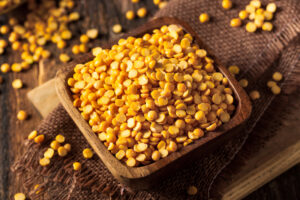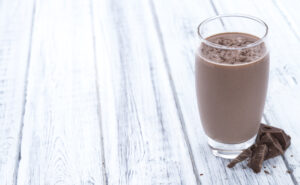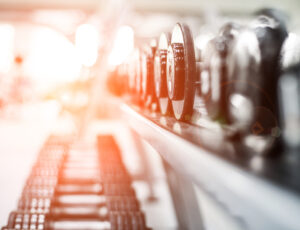Author Kristen Carli, MS, RD
Choosing the right protein source to support your fitness goals and overall health is important. With so many protein supplements available, it’s hard to know which one to choose. You may be wondering about the differences between pea protein and whey protein, and which one you should choose. Whether you’re a dedicated fitness enthusiast or simply looking for a clean, natural protein source, read on to find out which one is best for you.
What is Pea Protein
Pea protein powder is a nutritional supplement made by extracting protein from yellow peas, a naturally occurring plant-based protein source. It is a high-quality protein and a great source of iron.
Pea protein powder offers a range of health benefits, making it a popular choice for individuals seeking a clean and plant-based protein source. It can support muscle growth, weight loss, and heart health along with other potential health benefits.
Pea protein powder is often used to increase the protein content of smoothies and shakes and it’s suitable for almost any diet since it’s naturally vegan and hypoallergenic.
How is Pea Protein Made

The production of pea protein starts with the humble yet nutritious legume: the yellow split pea. These peas are typically grown abundantly, making them an environmentally friendly choice for protein supplementation.
Yellow split peas are cultivated and harvested when they reach maturity. Once harvested, the peas undergo a thorough cleaning process to remove any dirt, debris, or impurities. This cleaning ensures that the final product is of the highest quality. After cleaning, the peas are milled into a fine flour-like consistency.
The milled pea flour is mixed with water to create a slurry. This slurry is then subjected to a separation process that isolates the protein from the fiber and starch. This step is crucial for obtaining a highly concentrated protein extract.
The pea protein slurry goes through multiple filtration steps to remove non-protein components, leaving behind a pure protein solution. The protein-rich solution is then dried to remove excess moisture. This drying process typically uses low temperatures to preserve the protein’s quality and nutritional integrity. The end result is a pea protein powder with a high protein content, often exceeding 80% or more.
Finally, the dried pea protein powder is packaged into containers or bulk bags, ready for distribution to consumers, food manufacturers, or supplement companies.
What is Whey Protein
Whey protein is the most commonly used protein supplement in the fitness world. It is derived from cow’s milk during the cheese-making process. It is a complete protein, meaning it contains all the essential amino acids required by the body.
How is Whey Protein Made
 Whey protein is made by separating the liquid whey from the solid curds in milk. After this, it undergoes a series of filtration and drying processes to create whey protein powder. It may be processed into either whey concentrate or whey isolate protein.
Whey protein is made by separating the liquid whey from the solid curds in milk. After this, it undergoes a series of filtration and drying processes to create whey protein powder. It may be processed into either whey concentrate or whey isolate protein.
The process begins with the collection of fresh milk. The quality of the milk used is critical, as it directly affects the quality of the resulting whey protein.
The collected milk is pasteurized to eliminate harmful bacteria and pathogens. Pasteurization involves heating the milk to a specific temperature for a set period, effectively making it safe for consumption.
To separate the liquid whey from the solid curds, an enzyme called rennet or an acid, such as lemon juice or vinegar, is added to the pasteurized milk. This process initiates coagulation, leading to the formation of curds and whey. The curds are used to make cheese, while the whey is the liquid portion rich in proteins.
The curds and whey mixture is then separated, typically through a filtration or centrifugation process. This separation leaves behind the liquid whey, which contains proteins, minerals, and lactose.
The liquid whey undergoes additional filtration to remove any remaining impurities and fats. This filtration process results in whey protein concentrate, which contains a high percentage of protein. The concentration level can vary, with some products containing around 80% protein or more.
To create whey protein powder, the liquid whey concentrate is dried. Various methods can be used for drying, including spray drying and drum drying. During this process, the liquid is transformed into a fine powder, leaving behind a highly concentrated whey protein powder with minimal moisture content.
Pea Protein vs Whey: The Differences
 While pea protein and whey protein are both useful options for increasing protein intake to support various health and fitness goals, there are some key differences to be aware of when deciding which one is best for you.
While pea protein and whey protein are both useful options for increasing protein intake to support various health and fitness goals, there are some key differences to be aware of when deciding which one is best for you.
1. Amino Acid Profile
There are 20 different amino acids used in the body for metabolism, protein synthesis, and other important functions. Nine of these amino acids must be consumed from food or supplements because the body cannot make them on its own. These are considered essential amino acids.
Pea protein contains all essential amino acids but is low in the essential amino acid methionine compared to whey. Methionine plays a critical role in metabolism and protein synthesis, so getting enough of this important nutrient is essential for health and fitness goals. While it’s not as methionine-rich as whey, pea protein can still effectively support muscle growth and repair.
Pea protein is also low in the amino acid leucine, which is one of the most important amino acids for muscle protein synthesis. More on this later.
Whey protein is rich in all 9 essential amino acids, including methionine and leucine, making it an excellent choice for stimulating muscle protein synthesis and promoting muscle recovery.
2. Completeness as a Protein Source
Although pea protein contains all essential amino acids, it does not provide them in sufficient amounts. Pea protein is not considered a complete source of protein on its own because it lacks sufficient methionine. However, this can be easily addressed by combining pea protein with other complementary plant-based protein sources or foods rich in methionine.
Whey protein is a complete protein, containing all essential amino acids in the right proportions, which makes it a convenient and popular choice for meeting protein needs.
3. Muscle-Building Potential
Pea protein is a suitable choice for muscle growth and recovery, especially for individuals who are following a vegan diet or want to avoid dairy. While it may not match whey’s methionine content and absorption speed, it can still support muscle development effectively.
Whey protein is often preferred for muscle-building purposes due to its rapid absorption, high methionine and leucine content, and status as a complete protein. It’s an ideal choice for those looking to maximize muscle protein synthesis.
4. Digestibility and GI Comfort
Pea protein is generally easier on the stomach and less likely to cause digestive discomfort, making it a favorable option for individuals who experience bloating or gas with whey protein. During processing, fiber and starch are removed from the pea protein, resulting in a highly digestible protein source.
People with allergies or intolerances to gluten and dairy may find that pea protein powder is easier to digest than whey protein. They may feel less gassy or bloated when they use it instead of whey protein.
5. Lactose Content
Pea protein is naturally lactose-free, making it an excellent choice for individuals with lactose intolerance or those who want to avoid dairy.
Whey protein is a dairy product and therefore contains lactose. However, there are certain filtering processes that can be used to produce what is called whey protein isolate. Whey isolate contains little to hardly any lactose and is a good alternative for people with lactose intolerance.
Is Pea a Complete Protein?
Technically, pea protein is not a complete protein, but that doesn’t mean that it’s inferior to other protein sources.
Complete proteins contain all 9 of the essential amino acids (EAAs) that your body cannot produce on its own. The 9 EAAs include tryptophan, threonine, isoleucine, leucine, lysine, methionine, phenylalanine, valine, and histidine. Even if a protein contains all 9 of these amino acids, it isn’t considered complete if it doesn’t provide adequate amounts of each one.
Pea protein contains all 9 EAAs, but it’s not considered a complete protein because it only provides a small amount of methionine+cysteine. A complete protein provides at least 25 mg/g of this amino acid, and pea protein only has around 11 mg/g.
If you choose pea protein, you can easily combine it with other protein sources, either plant-based or animal-based.
How to Complete Pea Protein?
To ensure you are getting enough methionine in your diet, eat more eggs, dairy, chicken, beef, or fish.
Methionine deficiency is only an issue if you’re not eating any other sources of this amino acid. Many vegetarians and vegans purposely combine complementary plant-based proteins to make sure they are getting enough of all 9 essential amino acids. Since pea protein is only short on one amino acid, eating a well-rounded diet in addition to supplementation will ensure you are getting the maximum benefit.
If you want to combine plant-based proteins to make pea protein complete, brown rice, hemp seeds, whole grains, sunflower seeds, and Brazil nuts can create a complete protein that rivals whey in terms of muscle-building potential.
Is Pea a Good Alternative to Whey for Muscle?
 We already know that whey is a complete protein and pea protein is not, due to its lower levels of methionine. But there’s a more important piece to the puzzle here that we briefly mentioned before – it’s the essential amino acid leucine.
We already know that whey is a complete protein and pea protein is not, due to its lower levels of methionine. But there’s a more important piece to the puzzle here that we briefly mentioned before – it’s the essential amino acid leucine.
There are 3 branch-chain amino acids (BCAAs) that are the most effective of all the amino acids for stimulating muscle protein synthesis (the process of building muscle), and leucine in particular is the only amino shown to stimulate muscle protein synthesis on its own.
In other words, leucine is the most important amino acid in the body when it comes to building muscle. Whey has the highest leucine content of all protein sources, and that’s why whey is considered the G.O.A.T. of protein supplements in the health and fitness world.
Whey has 105 mg of leucine per gram of protein, while pea protein contains only about 81 mg of leucine per gram. That’s a 25% difference in leucine between whey and pea proteins, which is significant, but it doesn’t mean that pea protein can’t support muscle gain.
The International Society of Sports Nutrition suggests that the optimal amount of leucine for muscle growth is between 0.7 grams and 3 grams per serving, and studies show that getting more than the top end of that range does not stimulate muscle building any more than the lower end of the range.
Studies show that pea protein supports muscle growth just as well as whey protein. The real difference is that it takes less whey protein to deliver the optimal amount of leucine than it does pea protein. You may have to take a little bit more pea protein – 1.5 – 2 scoops – than you would whey protein, but you can still achieve the same muscle gains.
Is Pea Protein More Digestable Than Whey?
You may worry that pea protein may not be as digestible as whey, or that it may cause gas and bloating like when you eat whole peas, beans, or other legumes. Not to worry – the processing of pea protein removes the fiber and starch that would normally cause bloating, so the chance of digestive stress with pea protein is minimal.
Pea protein has a 94% rate of digestibility, meaning almost all of it will break down during digestion and cause little stress to your gut.
Pea protein also scores well when it comes to bioavailability, which just refers to how much of the protein can actually be absorbed and used by the body. It’s not quite as bioavailable as the animal proteins whey, casein, egg, and other meat sources, but it’s higher than other plant-based proteins like soy, hemp, and bean.
Is Pea Protein Good for Lactose Intolerance?
Pea protein is naturally lactose-free, so it can be good for those who have lactose intolerance.
Many people with lactose intolerance can safely consume whey isolate with minimal gastrointestinal upset. The processing of whey isolate removes much if not all of the lactose from the protein.If you have lactose intolerance and you wish to stay away from dairy entirely, pea protein is a good option.
Pea vs. Whey: How to Choose the Right One for Me?
When deciding between pea protein and whey protein, consider your specific dietary preferences, allergies, and fitness goals:
Choose Pea Protein If:
- You’re lactose intolerant, vegan, or have dairy allergies
- You prefer plant-based or vegan protein sources
- Digestive comfort is a priority for you
Choose Whey Protein If:
- You’re not lactose intolerant and can tolerate dairy
- You’re looking for a complete protein source with a high leucine content for muscle growth
- You want a protein source with rapid absorption, ideal for post-workout recovery
Conclusion
Both pea protein and whey protein have their benefits. Deciding which one is right for you basically comes down to your individual needs and preferences. Both options can effectively support muscle building your fitness journey with their high-quality, natural ingredients.
